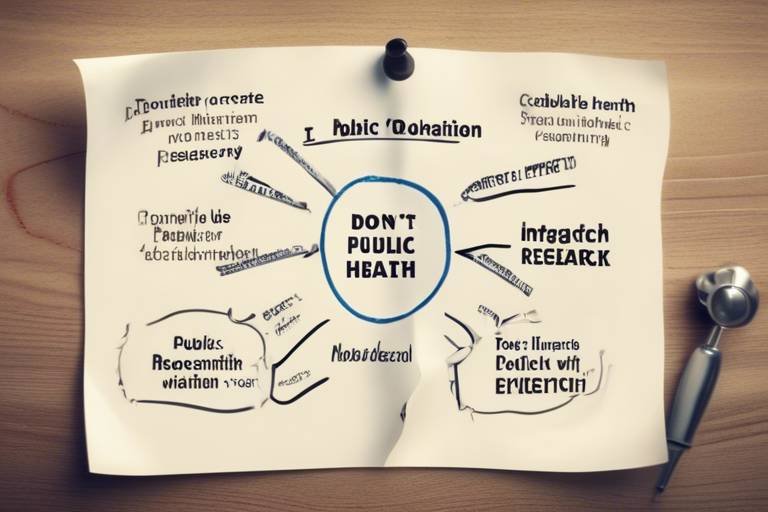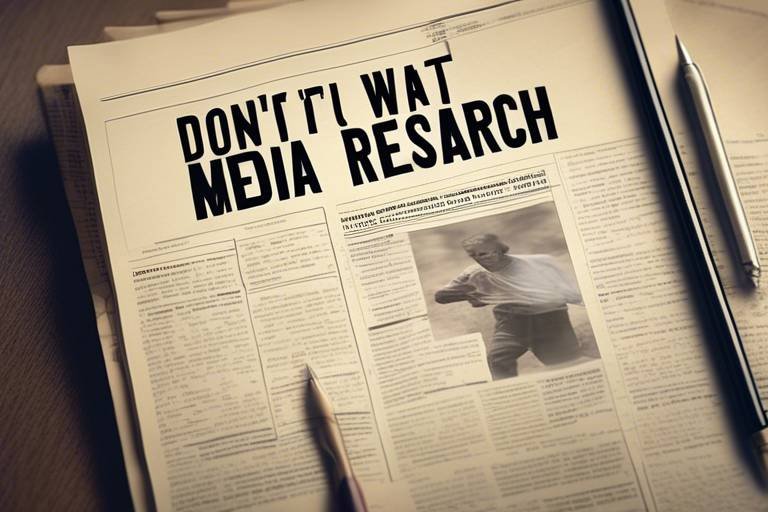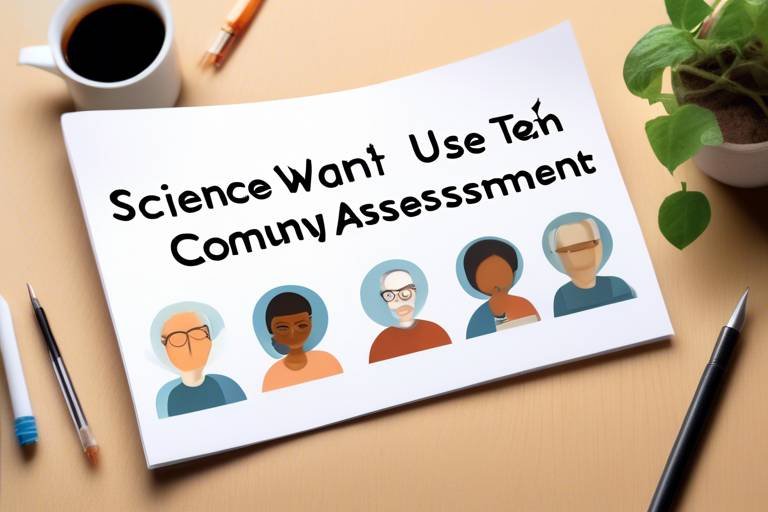How to Integrate Public Health Research with Policy
Integrating public health research with policy is more than just a good idea; it's a necessity for fostering healthier communities. Imagine a world where every health decision made by policymakers is backed by solid evidence. Sounds appealing, right? This integration is crucial in ensuring that the health interventions we implement are not only effective but also tailored to the specific needs of the population. Research provides the data, while policy translates that data into action. This article will explore effective strategies for merging these two crucial components, emphasizing the importance of evidence-based decisions for improving community health outcomes.
When it comes to public health initiatives, relying on evidence-based policy is key. Why? Because decisions made without substantial research can lead to wasted resources and missed opportunities for improving health outcomes. Evidence-based policy enhances public health initiatives by ensuring that the strategies we implement are grounded in scientific research. This not only increases the likelihood of success but also builds trust among community members who want to see their health improve.
For instance, consider a community struggling with high rates of obesity. If policymakers base their interventions solely on assumptions or outdated information, they might implement programs that don't resonate with the community's actual needs. However, by utilizing current research, they can identify effective strategies, such as promoting local farmer's markets or enhancing physical activity programs, tailored to the community's unique circumstances.
Identifying and engaging key stakeholders is essential for successful integration. These stakeholders include researchers, policymakers, and community members, all of whom play a vital role in shaping health policies that reflect public needs. Each group brings unique perspectives and expertise to the table, making collaboration imperative.
Effective collaboration fosters mutual understanding and shared goals. Researchers often have the data and insights needed to inform policy, while policymakers understand the practical implications of implementing these findings. By working together, they can create policies that are not only scientifically sound but also feasible and sustainable.
Establishing trust is vital for collaboration. Without it, researchers may feel their work is undervalued, while policymakers may disregard research findings as irrelevant. To build strong relationships, both parties should engage in open communication, share successes and challenges, and celebrate joint achievements. Regular meetings and workshops can be effective in fostering this trust and ensuring that everyone is on the same page.
Joint research agendas can align interests and facilitate collaboration. By developing shared research priorities, researchers and policymakers can ensure that the studies conducted are relevant to current health issues. This alignment can lead to more effective public health policies that truly address the needs of the community.
Translating research findings into actionable policies is a complex process that requires careful planning and execution. Frameworks such as the Knowledge-to-Action Framework can help bridge the gap between research and practical implementation in public health. This framework emphasizes the importance of adapting research findings to fit the local context and ensuring that stakeholders are involved throughout the process.
Identifying and addressing barriers is crucial for successful integration. Common challenges faced when merging public health research with policy include political dynamics, institutional frameworks, and funding constraints. Understanding these barriers is the first step in overcoming them.
Political dynamics and institutional frameworks can hinder integration. For example, shifts in political leadership may lead to changes in health priorities, making it difficult for research to be translated into practice. Additionally, some institutions may have rigid structures that resist change. Navigating these challenges requires a strategic approach, including advocacy and coalition-building among stakeholders.
Resource constraints can limit the application of research findings. Funding plays a critical role in public health research and policy integration. Without adequate financial support, it becomes challenging to implement evidence-based policies effectively. Emphasizing the need for sustainable investment in health initiatives is vital to ensure that research can lead to tangible health improvements.
- What is evidence-based policy? Evidence-based policy refers to the practice of making policy decisions based on the best available research evidence, rather than on assumptions or opinions.
- Why is collaboration between researchers and policymakers important? Collaboration ensures that policies are informed by the latest research, making them more effective and relevant to community needs.
- What are some common barriers to integrating research and policy? Common barriers include political dynamics, institutional resistance, and funding constraints.

The Importance of Evidence-Based Policy
In the realm of public health, the phrase “evidence-based policy” has become a cornerstone for effective decision-making. But what does it really mean? At its core, evidence-based policy refers to the practice of grounding health policies in rigorous research and empirical data. This approach is not just a trendy buzzword; it’s a critical methodology that can significantly enhance the efficacy of health initiatives. Imagine trying to navigate a ship without a compass—this is akin to making health policy decisions without relying on solid evidence. The consequences can be dire, impacting community health outcomes and resource allocation.
One of the most compelling arguments for adopting evidence-based policies is the potential for improved health outcomes. When policymakers utilize research findings, they are better equipped to address the specific needs of the population. For example, studies have shown that communities that implement evidence-based interventions experience a 25% reduction in chronic disease rates compared to those that don’t. This statistic alone underscores the importance of integrating robust research into policy frameworks.
Moreover, evidence-based policy fosters accountability. When health initiatives are backed by data, it becomes easier to measure their effectiveness. Policymakers can track outcomes, assess the impact of their decisions, and make necessary adjustments. This iterative process not only enhances the quality of health services but also builds public trust. Citizens are more likely to support policies that are transparent and demonstrably effective.
However, the journey toward evidence-based policy is not without its challenges. It requires a cultural shift among stakeholders, including researchers, policymakers, and the community at large. Many policymakers may feel overwhelmed by the sheer volume of research available, leading to the question: How can we streamline this information into actionable policies? The answer lies in fostering collaboration and communication between these groups. Researchers must present their findings in an accessible manner, while policymakers need to actively seek out and utilize this information.
In summary, the importance of evidence-based policy in public health cannot be overstated. It serves as a guiding star for decision-makers, ensuring that health interventions are not just well-intentioned but also effective. By prioritizing research-based strategies, we can pave the way for healthier communities, more efficient use of resources, and ultimately, a better quality of life for all.
- What is evidence-based policy? Evidence-based policy refers to the practice of making policy decisions based on rigorous research and empirical data.
- Why is evidence-based policy important? It enhances health outcomes, fosters accountability, and builds public trust in health initiatives.
- How can researchers and policymakers work together? By improving communication and collaboration, researchers can present findings in an accessible way, while policymakers can actively seek out this information.

Key Stakeholders in Public Health
When we talk about public health, it’s essential to recognize that it’s not just a one-person show. The landscape is filled with a variety of key stakeholders who play significant roles in shaping health policies and initiatives. Understanding who these players are and how they interact can be the difference between a successful health program and a missed opportunity. So, let’s break this down!
First off, we have researchers. These individuals are the backbone of public health. They conduct studies, analyze data, and provide the evidence that policymakers need to make informed decisions. Without their rigorous work, we would be flying blind, relying on guesswork rather than solid evidence. Researchers not only identify health trends but also evaluate the effectiveness of existing policies, making their role vital in the cycle of public health improvement.
Next up are the policymakers. These are the folks who take the research and turn it into action. They draft legislation, allocate funding, and create programs that aim to improve health outcomes in communities. However, they often face the challenge of balancing various interests and pressures, which can make it tough to implement evidence-based policies. Engaging with researchers can provide them with the insights needed to navigate these complexities.
Then we have the community members, the very people that health policies aim to serve. Their input is crucial because they are the ones who experience the direct impact of health initiatives. Community members can provide valuable feedback on health programs, ensuring that policies are not only effective but also culturally relevant and accessible. It’s like having a GPS for public health; without community input, policymakers might miss the mark.
The interplay between these stakeholders is where the magic happens. For example, consider a situation where a researcher uncovers a rise in obesity rates among children in a specific community. This finding can prompt policymakers to develop targeted interventions, such as nutrition education programs in schools. Meanwhile, community members can help shape these programs by sharing their insights into local eating habits and preferences.
To visualize this interaction, here’s a simple table that summarizes the roles of these key stakeholders:
| Stakeholder | Role | Impact on Public Health |
|---|---|---|
| Researchers | Conduct studies and provide evidence | Informs policy decisions and health interventions |
| Policymakers | Draft legislation and allocate resources | Transforms research into actionable policies |
| Community Members | Provide feedback and insights | Ensures policies meet local needs and preferences |
In conclusion, the integration of public health research and policy is a collaborative effort that requires the engagement of all these stakeholders. By fostering strong relationships and open communication between researchers, policymakers, and community members, we can create a more effective public health system that truly meets the needs of the population. So, let’s keep the conversation going and work together to ensure that everyone has a voice in shaping their health!

Collaboration Between Researchers and Policymakers
Collaboration between researchers and policymakers is not just beneficial; it's essential for creating effective public health strategies. Imagine a bridge connecting two islands—one representing the world of research and the other, the realm of policy. When these two entities come together, they can share resources, knowledge, and insights that ultimately lead to healthier communities. However, this partnership is often easier said than done. It requires a commitment to understanding each other's languages, priorities, and challenges.
One of the primary strategies for fostering collaboration is to establish regular communication channels. Just like a well-tuned orchestra, where every instrument plays in harmony, researchers and policymakers need to be in sync. This can involve regular meetings, joint workshops, or even informal coffee chats to discuss ongoing projects and emerging health issues. The goal here is to create a culture where both parties feel comfortable sharing ideas and concerns, which can lead to innovative solutions.
Another crucial aspect of this collaboration is the development of shared objectives. Researchers often focus on data and statistics, while policymakers are concerned with the practical implications of those findings. By aligning their goals, both parties can work towards a common vision. For instance, if researchers are investigating the impacts of air quality on public health, policymakers can use that data to draft regulations aimed at reducing pollution. This synergy not only enhances the relevance of research but also ensures that policies are grounded in solid evidence.
Furthermore, creating joint research agendas can significantly enhance collaboration. When researchers and policymakers come together to define what questions need to be answered, they can ensure that the research conducted is directly applicable to real-world issues. This is akin to a chef and a farmer collaborating to create a menu based on seasonal produce—both parties benefit when they work together to meet the needs of their customers.
However, it’s important to acknowledge that building this collaborative relationship takes time and effort. Trust is the foundation of any successful partnership. Researchers must understand the political landscape in which policymakers operate, while policymakers should appreciate the complexities of conducting scientific research. To foster this trust, it can be helpful to share success stories where collaboration has led to positive health outcomes. For example, initiatives that successfully reduced smoking rates often stemmed from research informing policy changes.
In conclusion, the collaboration between researchers and policymakers is a dynamic and ongoing process that requires commitment, communication, and trust. By working together, they can create a robust public health framework that not only addresses current challenges but also anticipates future health needs. This partnership is not just about sharing data; it's about building a healthier future for everyone.

Building Trust and Relationships
Building trust and relationships between researchers and policymakers is akin to nurturing a delicate plant; it requires patience, understanding, and consistent care. Trust is the foundation upon which effective collaboration is built, and without it, even the most well-intentioned initiatives can falter. One of the first steps in fostering this trust is through open communication. Researchers need to convey their findings in a way that is not only accessible but also relevant to the policymakers' needs. This means avoiding jargon and presenting data in a straightforward manner that highlights its implications for public health.
Moreover, regular engagement is crucial. By scheduling consistent meetings and discussions, both parties can stay aligned on goals and expectations. It’s important for researchers to understand the challenges that policymakers face and vice versa. This mutual understanding can be achieved through informal gatherings, workshops, or even joint training sessions. When both sides come together in a less formal environment, it opens the door for candid conversations, leading to stronger relationships.
Another effective strategy is to involve policymakers early in the research process. When researchers seek input from policymakers during the formulation of research questions or study designs, it not only enhances the relevance of the research but also allows policymakers to feel invested in the outcomes. This collaborative approach can significantly increase the likelihood that research findings will be translated into actionable policies.
To further strengthen these relationships, it is essential to acknowledge and celebrate successes together. When a research initiative leads to a successful policy change, both researchers and policymakers should take the time to recognize their joint efforts. This not only builds morale but also reinforces the value of collaboration in achieving public health goals.
In summary, building trust and relationships between researchers and policymakers is a dynamic process that requires ongoing effort. By prioritizing communication, engagement, collaboration, and recognition of shared successes, both parties can create a robust partnership that ultimately leads to improved public health outcomes.
- Why is trust important between researchers and policymakers?
Trust fosters open communication and collaboration, which are essential for effective public health initiatives. - How can researchers ensure their findings are relevant to policymakers?
By engaging with policymakers early in the research process and presenting data in an accessible manner. - What role does communication play in building relationships?
Open and consistent communication helps to align expectations and build a mutual understanding of challenges. - Why should successes be celebrated together?
Recognizing joint efforts boosts morale and reinforces the value of collaboration in public health.

Creating Joint Research Agendas
In the realm of public health, is not just a buzzword; it's a vital strategy that can lead to impactful health policies and interventions. Imagine a world where researchers and policymakers work hand-in-hand, aligning their goals to tackle pressing health issues. This partnership can significantly enhance the relevance and applicability of research findings, ensuring that they address the actual needs of the community. But how do we get there?
First and foremost, establishing a shared understanding of priorities is essential. Both researchers and policymakers bring unique perspectives to the table, and recognizing these differences can pave the way for fruitful collaboration. By engaging in open dialogues, stakeholders can identify key health challenges that require immediate attention. For instance, if a community is grappling with rising obesity rates, a joint research agenda could focus on studying effective interventions that have worked in similar demographics.
Moreover, it’s crucial to involve community members in this process. Their insights can provide valuable context that researchers and policymakers might overlook. By incorporating community feedback, joint research agendas can be tailored to reflect the actual needs and concerns of the population. This not only enhances the relevance of the research but also fosters a sense of ownership among community members, making them more likely to support and engage with the initiatives.
Another important aspect is the development of clear communication strategies. Researchers often speak a different language than policymakers, filled with technical jargon and complex data. To bridge this gap, it’s beneficial to create accessible summaries of research findings that highlight key implications for policy. Regular workshops and meetings can also facilitate ongoing dialogue, ensuring that both parties remain aligned throughout the research process.
In addition, establishing a framework for evaluating the effectiveness of joint research agendas is critical. This framework should include measurable outcomes that reflect both research and policy objectives. By periodically assessing the impact of their collaborative efforts, stakeholders can adapt their strategies as needed, ensuring that they remain responsive to evolving public health challenges.
Ultimately, the success of joint research agendas relies on the commitment of all parties involved. It’s about fostering a culture of collaboration where researchers, policymakers, and community members are dedicated to working together for the greater good. When everyone is on the same page, the potential for creating effective and sustainable public health policies becomes not just a possibility, but a reality.
- What is a joint research agenda? A joint research agenda is a collaborative framework developed by researchers and policymakers to align their research priorities with community health needs.
- Why is collaboration important in public health? Collaboration ensures that research findings are relevant and applicable to real-world challenges, leading to more effective health interventions.
- How can community members contribute to research agendas? Community members can provide insights and feedback that help shape research priorities, ensuring that they address the actual needs of the population.
- What are some challenges in creating joint research agendas? Challenges include communication barriers, differing priorities, and the need for ongoing commitment from all stakeholders involved.

Translating Research into Practice
Translating research into practice is like taking a beautifully crafted recipe and actually cooking the dish. It’s one thing to have the ingredients and instructions laid out, but it’s a whole other ball game to bring that dish to life and serve it to the community. In the realm of public health, this translation process is crucial because it ensures that the findings from rigorous research are not just gathering dust on a shelf but are actively shaping policies that can improve health outcomes. The challenge lies in bridging the gap between the theoretical knowledge produced by researchers and the practical application needed by policymakers.
One effective method for achieving this translation is through the use of frameworks that guide the implementation process. For example, the Knowledge-to-Action Framework provides a structured approach to move knowledge into practice by identifying barriers and facilitators within the healthcare environment. It emphasizes the importance of not just disseminating information but also actively engaging stakeholders in the process. This means that researchers need to communicate their findings in a way that is accessible and relevant to policymakers, who often operate under tight deadlines and need clear, actionable insights.
Moreover, establishing partnerships between researchers and practitioners is essential. These collaborations can take many forms, such as joint workshops or community forums, where both parties can share insights and experiences. For instance, when researchers work closely with healthcare providers, they can gain valuable feedback on the practical challenges faced in implementing certain health interventions. This two-way street not only enhances the relevance of the research but also fosters a sense of ownership among practitioners, making them more likely to adopt the findings in their work.
Another key aspect of translating research into practice is evaluation. Implementing a new health policy or intervention is not the end of the road; it’s just the beginning. Continuous evaluation allows for the assessment of the effectiveness of the implemented strategies. It helps to identify what’s working, what isn’t, and why. This feedback loop is vital for making necessary adjustments and ensuring that the health interventions remain effective and relevant to the community’s needs.
To further illustrate this process, consider the following table that outlines the steps involved in translating research into practice:
| Step | Description |
|---|---|
| 1. Identify Research Findings | Gather relevant research that addresses public health issues. |
| 2. Engage Stakeholders | Involve community members, policymakers, and practitioners early in the process. |
| 3. Develop Implementation Strategies | Create actionable plans based on research findings. |
| 4. Monitor and Evaluate | Assess the impact of the implemented strategies and make necessary adjustments. |
In conclusion, translating research into practice is a dynamic and ongoing process that requires collaboration, communication, and commitment from all parties involved. By fostering strong partnerships, utilizing effective frameworks, and continuously evaluating interventions, we can ensure that public health research leads to meaningful changes in health policies and, ultimately, improved health outcomes for communities.
- What is the main goal of translating research into practice?
The main goal is to ensure that research findings are applied in real-world settings to improve public health outcomes. - How can stakeholders be effectively engaged in this process?
Stakeholders can be engaged through workshops, forums, and collaborative projects that encourage open communication and feedback. - Why is evaluation important in this context?
Evaluation helps to assess the effectiveness of health interventions and allows for adjustments to be made based on the feedback received.

Barriers to Integration
Integrating public health research with policy is not as straightforward as it might seem. There are numerous barriers that can obstruct this essential collaboration, and understanding these obstacles is the first step toward overcoming them. One of the most significant challenges is the gap between the academic world and the practical realities of policy-making. Researchers often operate in a realm of theoretical models and statistical analyses, while policymakers are focused on immediate community needs and political pressures. This divergence can lead to misunderstandings and a lack of alignment on priorities.
Moreover, the political landscape plays a crucial role in shaping public health policies. Political agendas can shift rapidly, and what is deemed important today may not hold the same weight tomorrow. This instability can result in a lack of sustained support for research initiatives that are crucial for long-term public health improvements. For instance, if a promising study is released but does not align with current political priorities, it may be ignored, regardless of its potential benefits.
Another significant barrier is the issue of funding and resource allocation. Public health research often requires substantial investment, yet funding is frequently limited or misallocated. Policymakers may prioritize immediate needs over long-term research funding, leading to a cycle where research is underfunded and, consequently, less relevant to policy decisions. The table below illustrates the typical funding challenges faced in public health research:
| Funding Challenge | Description |
|---|---|
| Limited Budgets | Many public health departments operate under tight budgets, restricting their ability to fund research. |
| Short-Term Focus | Funding often supports short-term projects rather than long-term research initiatives. |
| Competition for Resources | Numerous health issues compete for limited funding, making it difficult for specific research projects to secure necessary resources. |
Additionally, there is often a lack of communication between researchers and policymakers. Researchers may not effectively communicate their findings in a way that is accessible to policymakers, who might lack the technical background to grasp complex research data. This disconnect can lead to missed opportunities for evidence-based policy-making. Bridging this gap requires a concerted effort to present research in a clear, actionable format that highlights its relevance to current public health challenges.
Lastly, cultural differences between the two groups can create barriers. Researchers are typically trained to focus on data and empirical evidence, while policymakers may prioritize community sentiment and political feasibility. This difference in approach can lead to friction and misunderstandings, further complicating the integration process. Building a culture of collaboration, where both parties appreciate each other's perspectives, is essential for overcoming these barriers.
In conclusion, while there are significant barriers to integrating public health research with policy, understanding these challenges is the first step toward creating effective solutions. By fostering open communication, ensuring sustained funding, and building strong relationships, we can pave the way for policies that truly reflect the best available evidence and ultimately improve community health outcomes.
- What are the main barriers to integrating public health research and policy? The main barriers include political dynamics, funding constraints, communication gaps, and cultural differences between researchers and policymakers.
- How can we overcome these barriers? By fostering collaboration, ensuring sustained funding, and improving communication, we can enhance the integration of research and policy.
- Why is evidence-based policy important? Evidence-based policy ensures that health interventions are grounded in the best available research, leading to more effective public health outcomes.

Political and Institutional Challenges
When it comes to integrating public health research with policy, one of the most significant hurdles is navigating the political and institutional landscape. This realm is often filled with complexities that can stifle progress and hinder effective collaboration between researchers and policymakers. For instance, political agendas can shift, causing priorities to change rapidly, which may leave valuable research findings in the dust. Have you ever tried to convince someone of a great idea, only to have them dismiss it because it doesn’t align with their current goals? That's the reality for many public health advocates.
Moreover, institutional frameworks can create barriers that complicate the integration process. Different organizations may have varying missions, goals, and operational procedures, leading to a lack of cohesion. Imagine a group of musicians trying to play a symphony without a conductor; the result is often chaotic and unproductive. This analogy captures the essence of what happens when public health researchers and policymakers operate in silos without a unified strategy.
Some common political and institutional challenges include:
- Policy Inertia: Existing policies can be resistant to change, making it difficult to introduce new research findings.
- Competing Interests: Different stakeholders may have conflicting priorities, leading to a tug-of-war over which policies to prioritize.
- Lack of Communication: Poor communication channels can result in misunderstandings and missed opportunities for collaboration.
To navigate these challenges effectively, it’s essential to foster an environment of open dialogue and collaboration. Creating platforms where researchers and policymakers can regularly interact can help bridge the gap. Think of it as building a bridge over a river; without it, you’ll find yourself stuck on one side, unable to reach the other. Regular meetings, workshops, and joint initiatives can facilitate understanding and help align goals.
Furthermore, understanding the political landscape is crucial. Policymakers often operate under constraints that researchers may not fully appreciate. By acknowledging these limitations, researchers can tailor their approaches to be more palatable to decision-makers. This might involve presenting findings in a way that highlights their relevance to current political issues or demonstrating how implementing certain policies can lead to cost savings in the long run.
In conclusion, while political and institutional challenges can pose significant obstacles to integrating public health research with policy, they are not insurmountable. By fostering collaboration, enhancing communication, and understanding the political landscape, we can create a more conducive environment for translating research into actionable health policies that truly benefit communities.
- What are the main barriers to integrating public health research with policy?
The main barriers include political inertia, competing interests among stakeholders, and lack of effective communication channels. - How can researchers and policymakers improve collaboration?
Establishing regular communication through meetings, workshops, and joint initiatives can enhance collaboration. - Why is evidence-based policy important?
Evidence-based policy ensures that health interventions are grounded in solid research, leading to better health outcomes for communities.

Funding and Resource Allocation
This article explores effective strategies for merging public health research with policy-making processes, emphasizing the importance of evidence-based decisions for improving community health outcomes.
Understanding how evidence-based policy can enhance public health initiatives is crucial. This section discusses the benefits of relying on research findings to inform policy decisions and drive effective health interventions.
Identifying and engaging key stakeholders is essential for successful integration. This section highlights the roles of researchers, policymakers, and community members in shaping health policies that reflect public needs.
Effective collaboration fosters mutual understanding and shared goals. This subsection examines strategies to enhance communication and cooperation between researchers and policymakers in the public health realm.
Establishing trust is vital for collaboration. This part discusses methods to build strong relationships between researchers and policymakers, ensuring a productive partnership for public health improvement.
Joint research agendas can align interests. This section outlines how developing shared research priorities can facilitate collaboration and lead to more relevant public health policies.
Translating research findings into actionable policies is a complex process. This subsection explores methods and frameworks that can help bridge the gap between research and practical implementation in public health.
Identifying and addressing barriers is crucial for successful integration. This section discusses common challenges faced when merging public health research with policy and offers potential solutions to overcome them.
Political dynamics and institutional frameworks can hinder integration. This part analyzes how these factors impact the relationship between research and policy, suggesting ways to navigate these challenges effectively.
When it comes to the integration of public health research with policy, play a pivotal role. Insufficient funding can stifle innovative research and limit the ability of policymakers to implement evidence-based solutions. It's essential to understand that without adequate financial resources, even the most promising research can remain on the shelf, gathering dust, rather than being transformed into actionable policies that can benefit communities.
Moreover, the allocation of resources is often influenced by political priorities and institutional frameworks. This means that effective advocacy is necessary to ensure that public health initiatives receive the funding they require. For instance, consider the following factors that can impact funding decisions:
- Political Will: The commitment of political leaders to prioritize public health can significantly affect funding.
- Public Awareness: Increased public awareness and advocacy for health issues can lead to greater funding allocations.
- Partnerships: Collaborations between government, private sector, and non-profit organizations can pool resources for health initiatives.
To illustrate the importance of funding in public health, let's take a look at a simplified table that shows the relationship between funding levels and health outcomes:
| Funding Level | Health Outcomes |
|---|---|
| Low | Increased disease prevalence, limited access to care |
| Moderate | Improved health services, reduced disease rates |
| High | Enhanced public health initiatives, overall community wellness |
It's clear that higher funding levels correlate with better health outcomes. Therefore, it becomes imperative for researchers and policymakers to work together to advocate for increased funding. This collaboration can lead to the development of compelling evidence that demonstrates the return on investment in public health initiatives, ultimately persuading stakeholders to allocate necessary resources.
In conclusion, addressing funding and resource allocation is not just about securing dollars; it's about creating a sustainable framework that ensures public health research can be translated into effective policies. By fostering partnerships, raising public awareness, and advocating for political will, we can pave the way for healthier communities.
- What is the role of funding in public health research? Funding is crucial as it determines the scope and impact of research initiatives, directly influencing health outcomes.
- How can stakeholders advocate for more funding? Stakeholders can engage in public awareness campaigns, collaborate across sectors, and present data-driven arguments to policymakers.
- What are some common barriers to funding in public health? Common barriers include political priorities, lack of public interest, and competition for limited resources.
Frequently Asked Questions
- What is the significance of evidence-based policy in public health?
Evidence-based policy is crucial because it ensures that health interventions are grounded in solid research findings. This approach not only improves the effectiveness of health initiatives but also enhances accountability and transparency in decision-making. By relying on data, policymakers can make informed choices that lead to better health outcomes for communities.
- Who are the key stakeholders involved in public health research and policy?
Key stakeholders include researchers, policymakers, and community members. Researchers provide the necessary evidence and insights, while policymakers craft regulations and initiatives based on that information. Community members play a vital role by voicing their needs and concerns, ensuring that health policies are reflective of the population's requirements.
- How can researchers and policymakers collaborate effectively?
Effective collaboration can be achieved through open communication, regular meetings, and joint projects. By establishing common goals and understanding each other's perspectives, researchers and policymakers can work together to create health policies that are both practical and impactful. Trust-building activities, such as workshops and informal gatherings, can also enhance this partnership.
- What are the barriers to integrating public health research with policy?
Common barriers include political dynamics, institutional constraints, and funding limitations. Political agendas can sometimes overshadow research findings, while institutional frameworks may not support collaborative efforts. Additionally, insufficient funding can restrict the application of research in real-world settings. Addressing these challenges requires strategic planning and advocacy for sustainable investment in public health.
- How can research findings be translated into actionable policies?
Translating research into practice involves creating frameworks that guide policymakers in implementing findings. This can include developing clear guidelines, providing training for stakeholders, and ensuring ongoing evaluation of health initiatives. Engaging in pilot projects can also help test the feasibility of policies before wider implementation.
- What role does funding play in public health research and policy integration?
Funding is essential for supporting research initiatives and enabling the translation of findings into policy. Without adequate resources, it becomes challenging to conduct comprehensive studies or implement evidence-based interventions. Therefore, securing sustainable funding is vital for the continuous improvement of public health systems.



















